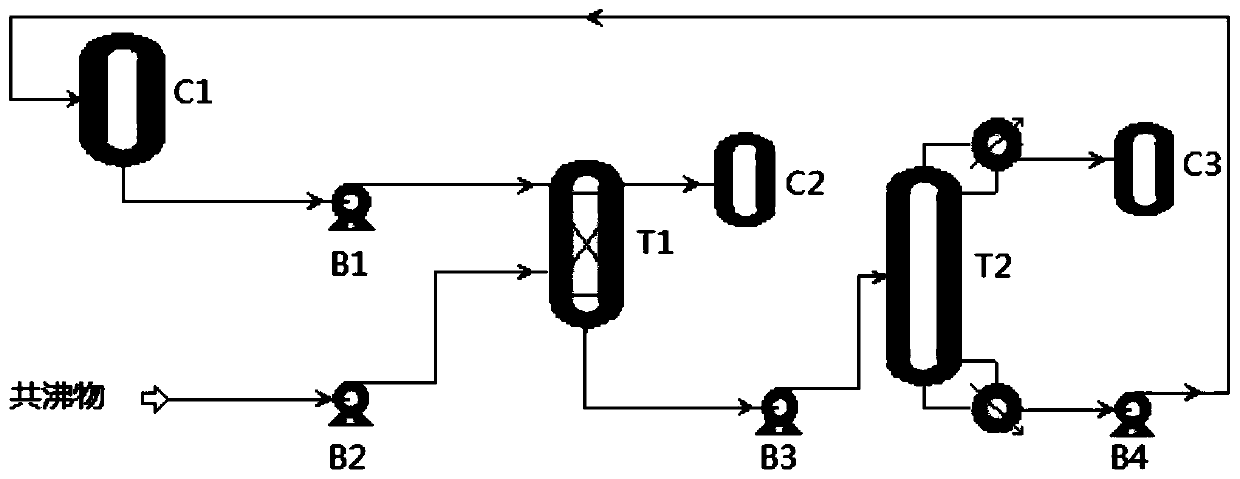Process for refining anisole
A technology of anisole and process, which is applied in the field of separation of anisole and water, can solve the problems of time-consuming, laborious, long-time, and difficult to handle, and achieve the effects of reducing separation cost, improving separation efficiency, and reducing reflux ratio
- Summary
- Abstract
- Description
- Claims
- Application Information
AI Technical Summary
Problems solved by technology
Method used
Image
Examples
Embodiment 1
[0015] like figure 1 As shown, the azeotrope of anisole and water is injected into the extraction tower T1 using the azeotrope feed pump B2, and the extractant is injected into the extraction tower T1 using the extractant feed pump B1, and the theoretical plate number of the extraction tower T1 is 10 blocks, the azeotrope feed position is at the 7th theoretical plate, and the extractant feed position is at the 2nd theoretical plate, wherein the extractant is 1,4-butanediol and sulfolane mass ratio is 1: 1 mixed solution, the feed mass ratio of extractant to azeotrope is 2:1, the reflux ratio of extraction tower T1 is controlled at 1:2, and the pressure is 0.01MPa. The water produced from the top of the extraction tower T1 enters the water storage tank C2, and the bottom product is pumped into the rectification tower T2 using the crude anisole feed pump B3. The rectification tower T2 has 6 theoretical plates, and the feed position is at At the third theoretical plate, the refl...
Embodiment 2
[0017] The refining method of this embodiment is the same as that of Example 1, except that the number of theoretical plates of the extraction tower T1 is 15, the azeotrope feeding position is at the 8th theoretical plate, and the extractant feeding position is at the 3rd theoretical plate. At the theoretical plate place, the extractant is a mixture of 1,4-butanediol and sulfolane in a mass ratio of 4:1, the mass ratio of the extractant to the azeotrope is 3:1, and the reflux ratio of extraction tower T1 is controlled as 1:4, pressure 0.05MPa; distillation column T2 has 10 theoretical plates, feed position is at the fourth theoretical plate, rectification column T2 reflux ratio is controlled to 1:0.5, pressure is 0.05MPa. After testing, the water content of anisole in the anisole storage tank C3 was 0.005%, and the chemical oxygen demand of water was not detected.
Embodiment 3
[0019] The refining method of this embodiment is the same as that of Example 1, except that the number of theoretical plates in the extraction tower T1 is 18, the azeotrope feeding position is at the 8th theoretical plate, and the extractant feeding position is at the 3rd theoretical plate. At the theoretical plate place, the extractant is a mixture of 1,4-butanediol and sulfolane in a mass ratio of 6:1, the mass ratio of the extractant to the azeotrope is 5:1, and the reflux ratio of extraction tower T1 is controlled as 1:10, pressure 0.1MPa; distillation column T2 has 12 theoretical plates, feed position is at the fourth theoretical plate, rectification column T2 reflux ratio is controlled to 1:1, pressure is 0.1MPa. After testing, the water content of anisole in the anisole storage tank C3 was 0.004%, and the chemical oxygen demand of water was not detected.
PUM
 Login to View More
Login to View More Abstract
Description
Claims
Application Information
 Login to View More
Login to View More - R&D
- Intellectual Property
- Life Sciences
- Materials
- Tech Scout
- Unparalleled Data Quality
- Higher Quality Content
- 60% Fewer Hallucinations
Browse by: Latest US Patents, China's latest patents, Technical Efficacy Thesaurus, Application Domain, Technology Topic, Popular Technical Reports.
© 2025 PatSnap. All rights reserved.Legal|Privacy policy|Modern Slavery Act Transparency Statement|Sitemap|About US| Contact US: help@patsnap.com

